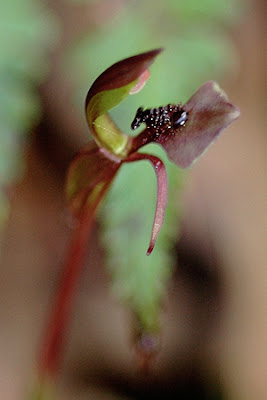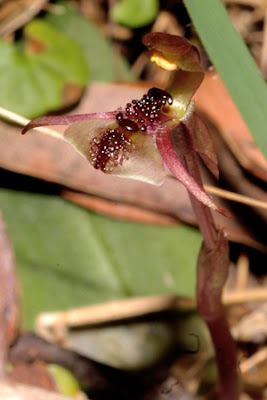This little thing is possibly Myrmechila trapeziformis (formerly classed in the genus Chiloglottis). The "labellum" is diamond shaped, and the glands are restricted to the "base" of the labellum (the part closest to the main part of the flower).
 I say troublesome, because of the problems of identifying these little plants. This is the same specimen as above, and you can see that the front part of the labellum is more or less clear of glands. Compare this species with the "roughly similar" Chiloglottis seminuda, which has a different shaped labellum and is in the autumn-flowered group of these plants.
I say troublesome, because of the problems of identifying these little plants. This is the same specimen as above, and you can see that the front part of the labellum is more or less clear of glands. Compare this species with the "roughly similar" Chiloglottis seminuda, which has a different shaped labellum and is in the autumn-flowered group of these plants. Did I say "identify"? I should firstly say "find"; and then again, "photograph".
Did I say "identify"? I should firstly say "find"; and then again, "photograph".Compare the gland structures of this next flower with the one above. The glands, (which are referred to by the Orchid specialists as a "pseudo-insect") extend down to the very tip of the labellum. These plants have developed a system of growing glands which physically resemble an insect, as well as mimicking the scent of the female insect (a wasp). This induces the male wasps to pollinate the flower, while attempting to mate with what the wasp believes is a female wasp, of its own species. In fact it is, of course, a flower. This process is known as "pseudo-copulation".
This species is almost certainly Myrmechila formicifera - the second name means "ant bearing" - in other words, the Orchid with an ant on its tongue (labellum).
 The way they hide in the leaf litter is one thing. Then, their little flowers are very 3 dimensional, and need to be photographed from above (to see the extent of the glands ("calli") on the labellum, from the side to show the angle of the labellum (how "upright" it is held) and front on to show the position and the shape of the column and the dorsal sepal behind it. And with such a small flower, it is very hard to focus on them anyway, but doing it while lying on the ground, in 3 different positions, (and, on Macquarie Pass, checking oneself for leeches every time you get up off the ground) is more than most of us can bear.
The way they hide in the leaf litter is one thing. Then, their little flowers are very 3 dimensional, and need to be photographed from above (to see the extent of the glands ("calli") on the labellum, from the side to show the angle of the labellum (how "upright" it is held) and front on to show the position and the shape of the column and the dorsal sepal behind it. And with such a small flower, it is very hard to focus on them anyway, but doing it while lying on the ground, in 3 different positions, (and, on Macquarie Pass, checking oneself for leeches every time you get up off the ground) is more than most of us can bear.
Looking "over the shoulder" of the flower, you can compare this species with the second top photograph above, in which the glands are restricted to the top half of the labellum.


2 comments:
ahhh, these pesky little ant orchids, hey?
Of course, I think they are absolutely delightful, but as you have pointed out some of the difficulties in photographing, I will also mention that I have had some troublesome episodes with the camera and ant orchids.
The only spring ones I have photographed (actually I got some photos of them in August too), is looking like your third photo with the calli all the way to the front of the labellum.
I haven't even begun to study my photos yet, but when time permits, I'll be looking forward to checking them out and investigating orchid material.
Once again, Denis, I have enjoyed your orchid observations and photographs.
Gaye
Hi Gaye
The puzzling thing with these little Orchids is that you find 90% of one species, then a few, just a few with different "calli" on the labellum. The books tell us that these are different species.
How likely is that? That 2 different species both find the same odd locality in the bush in which to grow.
It makes me wonder if what is presented as a good species, is in fact just some kind of variant?
Mind you, similar things do occur with the Greenhoods, where you get several species together in a grassy clearing in the middle of a huge area of rainforest (unsuitable habitat). How do they get there?
Another of life's little mysteries.
Cheers
Denis
Post a Comment